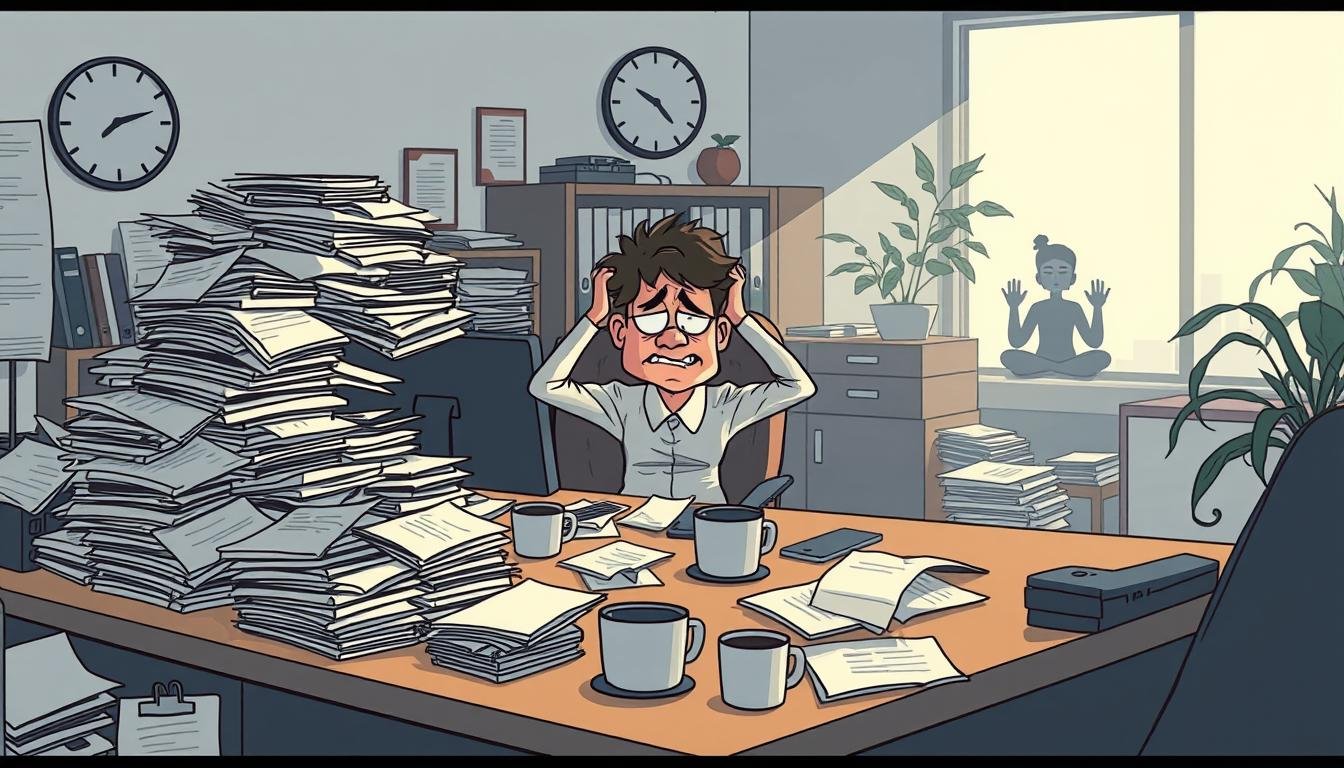Role Overload: Psychological Tips to Prevent Employee Burnout
Do you feel overwhelmed at work, struggling to keep up with endless tasks and responsibilities? You’re not alone. Role overload and employee burnout are common in today’s fast-paced work environment. Let’s explore this issue and find ways to maintain a healthy work-life balance.
Recent studies show a concerning picture of the modern workplace. A staggering 56% of workers face intense, high-pressure situations at work. Even more alarming, 19% report working overtime every single day. These statistics highlight the urgent need for addressing role overload and its impact on employee well-being.
Role overload happens when work demands are more than an individual can handle. This imbalance can lead to severe consequences, including psychological strain, reduced performance, and burnout. Understanding these challenges is crucial for both employees and organizations seeking to create healthier, more productive work environments.
Key Takeaways
- Role overload is a major contributor to employee burnout
- 56% of workers experience high-pressure work regularly
- 19% of employees work overtime daily
- Burnout can lead to reduced productivity and high turnover
- Effective stress management and work-life balance are essential for preventing burnout
Understanding Workplace Burnout
Workplace burnout is a big problem in today’s fast world. The WHO says it’s a syndrome caused by long-term stress at work. This shows how serious it is.
Impact on Individuals and Organizations
Burnout hurts both workers and companies. It makes people less productive and unhappy at work. It also leads to more people missing work and leaving their jobs.
The Cost of Burnout to Businesses
Burnout costs businesses a lot. In the U.S., it’s estimated to cost $300 billion a year. This includes lost productivity, more insurance claims, and people leaving their jobs.
| Burnout Factor | Impact on Employees | Impact on Business |
|---|---|---|
| Work Overload | Exhaustion, Stress | Decreased Productivity |
| Lack of Control | Frustration, Disengagement | Higher Turnover Rates |
| Poor Work-Life Balance | Health Issues, Resentment | Increased Absenteeism |
It’s important to understand and fight burnout. This helps keep workers healthy and productive. By spotting burnout early and taking steps to prevent it, companies can protect their employees and stay successful.
Identifying the Signs of Role Overload
Spotting burnout symptoms early is crucial to avoid full-blown burnout. Workplace stress shows up in many ways. It affects both the well-being of employees and the success of the company.
Emotional Exhaustion and Depersonalization
Feeling emotionally drained is a big sign of too much work. Employees might feel tired, cranky, and disconnected from their job. Feeling cynical and distant from others is another sign.
Physical and Psychological Symptoms
Too much work can harm your health. Look out for:
- Frequent headaches and muscle tension
- Sleep disturbances
- Upset stomach and digestive problems
- Increased susceptibility to illness
- Heightened anxiety and depression
Behavioral Changes in the Workplace
Changes in how employees act can show too much work. Look for:
- Decreased productivity and work quality
- Increased absenteeism and tardiness
- Reduced engagement and innovation
- Difficulty meeting deadlines
- Strained relationships with coworkers and clients
| Overload Indicator | Impact on Employee | Impact on Organization |
|---|---|---|
| Emotional Exhaustion | Decreased job satisfaction | Lower productivity |
| Physical Symptoms | Increased sick days | Higher absenteeism costs |
| Behavioral Changes | Reduced work quality | Damaged reputation |
Spotting these signs early helps prevent severe burnout. It saves both employees and companies from big problems.
The Causes of Employee Burnout
Employee burnout is a big problem in today’s workplaces. Many things in the workplace cause this issue. It’s key for employers and employees to know what causes burnout to fix it.
Job demands are a big reason for burnout. A study found that 23% of full-time workers often or always feel burned out. Another 44% feel burned out sometimes. So, about two-thirds of full-time workers face burnout.
Several things lead to employee burnout:
- Excessive workload
- Lack of control over work
- Insufficient rewards or recognition
- Poor workplace relationships
- Unfair treatment
- Misalignment between personal values and job requirements
The effects of these stressors are big. Burned-out employees are 63% more likely to take a sick day. They are 2.6 times as likely to look for a new job. They are also 23% more likely to go to the emergency room, showing burnout’s physical harm.
| Burnout Factor | Impact |
|---|---|
| Unfair treatment at work | 2.3 times more likely to experience high burnout |
| Supportive manager | 70% less likely to experience regular burnout |
| Adequate time for work | 70% less likely to experience high burnout |
These numbers show why we must tackle job demands and workplace stressors. By knowing what causes burnout, companies can make better work places. This helps support their employees’ health and happiness.
Role Overload: A Major Contributor to Burnout
Role overload is a big problem in the workplace. It happens when there’s too much work for one person to do. This is common in today’s fast-paced jobs.
Defining Role Overload
Role overload means too much work or responsibility without enough help. A study of 595 Chinese nurses showed it hurts their work and how they get along with others.
Impact on Work-Life Balance
Role overload affects work-life balance a lot. When there’s too much work, it’s hard to keep personal and work life separate. This can cause stress and burnout.
Consequences for Employee Well-being
Role overload is bad for employees. A survey by the American Medical Association found 47.3% of doctors felt burned out. Also, 24.3% wanted to quit in two years. These numbers show how serious the problem is:
| Factor | Impact |
|---|---|
| Work Overload | Increased burnout risk by 2.2 to 2.9 times |
| Job Leaving Intention | 1.7 to 2.1 times higher risk |
| Nurses Burnout Rate | 56% |
| Nurses Leaving Intention | 41% |
These results show we need to fix role overload. Companies must help employees to avoid burnout and keep them happy and healthy.
Strategies for Managers to Prevent Burnout
Managers are key in stopping employee burnout. They can make work better and help teams do their best.
Creating a Culture of Psychological Safety
Psychological safety stops burnout. Managers should make a place where everyone can share worries without fear. This lets them spot burnout early.
Demonstrating Empathy and Support
Being empathetic is vital in fighting burnout. Managers should listen with kindness and act on what they hear. Regular talks and help programs are big supports.
Optimizing Workload Distribution
Managing workloads well stops feeling overwhelmed. Managers should check who can do what and set fair deadlines. This keeps work balanced for everyone.
| Strategy | Impact |
|---|---|
| Regular supervision | Reduces burnout and turnover intentions |
| Addressing team conflicts | Improves morale and reduces burnout risk |
| Flexible work schedules | Enhances work-life balance and reduces stress |
| Professional development | Prevents burnout and improves retention |
By focusing on safety, empathy, and workload, managers can lower burnout risk. These steps help keep employees happy and productive.
Empowering Employees to Manage Stress
Workplace stress is a big problem, with 80% of workers feeling stressed at work. To tackle this, companies are focusing on empowering employees and building resilience. They provide resources and tools to help staff manage stress well.
One effective strategy is training in time and project management. These skills help employees handle their work better, reducing stress and boosting productivity. Companies also offer mindfulness and meditation sessions. These have been proven to lower anxiety and enhance well-being.
It’s also important to encourage employees to use available resources. Managers should lead by example and promote stress-reduction efforts. This not only helps individual employees but also makes the workplace more positive and productive.
“Empowering employees to manage their stress is not just about providing resources; it’s about creating a culture where using these resources is encouraged and valued.”
To support employee well-being, organizations can take several steps:
- Regular breaks throughout the workday
- Exercise programs or gym memberships
- Flexible work arrangements to improve work-life balance
- Encouraging employees to pursue hobbies and interests outside of work
- Promoting the use of vacation time for rest and rejuvenation
By investing in these strategies, companies can build a more resilient workforce. This workforce is better equipped to handle workplace challenges and maintain high performance.
Organizational Approaches to Reduce Burnout Risk
Companies are now focusing on reducing employee burnout. They’re using smart strategies to keep their teams healthy and productive.
Implementing wellness programs
Workplace wellness programs are becoming more common. These programs help employees stay healthy and manage stress. They often include fitness classes, health screenings, and nutrition advice.
Offering flexible work arrangements
Flexible work is a big help for many employees. It lets them balance their job and personal life better. This can mean working from home, adjusting hours, or job sharing.
A Gallup study found that employees working over 50 hours a week are at higher risk of burnout. Flexible work can help reduce these long hours.
Providing mental health resources
Mental health support is key in preventing burnout. Many organizations now offer Employee Assistance Programs (EAPs). These programs provide confidential counseling and support services.
Some companies also cover online therapy sessions or mindfulness apps.
By focusing on these areas, companies can create a healthier work environment. This not only helps employees but also benefits the business. The World Health Organization recognizes burnout as a workplace issue.
Taking action now can prevent future problems and boost productivity.
The Importance of Work-Life Integration
Work-life integration is key to avoiding burnout and boosting well-being. It’s about blending work and personal life, not just balancing them.
Balancing Professional and Personal Responsibilities
Good work-life integration means flexible schedules. This lets you handle work and personal life better. It’s about being flexible, knowing life doesn’t always stick to a plan. But, don’t overdo it to avoid burnout.
Encouraging Time Off and Disconnection
Time off policies are crucial for work-life integration. Companies should support regular breaks and encourage employees to step away from work outside of work hours. This helps avoid too much work and keeps work and family life separate.
Promoting Self-Care Practices
Self-care at work is vital for a healthy work-life balance. This includes taking breaks, staying active, and managing stress. Employers can help by offering wellness programs and mental health support.
“Work-life integration should foster personal development through continuous learning, setting goals, and prioritizing self-care and well-being.”
By focusing on work-life integration, companies can make employees happier, more productive, and create a better work place. This is especially good for small and medium-sized businesses, which are a big part of the global economy and workforce.
Conclusion
Burnout prevention strategies are key for keeping employees happy and healthy. Studies show that 64% of people see work as a big stress. This shows how important it is for companies to handle role overload well.
Role overload can cause anxiety and make work-life balance hard. It also lowers job satisfaction and commitment. But, the right approach can make people more creative and eager to learn.
Companies need to fight burnout to be strong. They should support their teams, offer flexible work, and provide mental health help. This way, they can keep their best workers, work better together, and create a better place to work.
Source Links
- Role Overload and Work Performance: The Role of Psychological Strain and Leader–Member Exchange
- 11 Tips to Avoid Work Overload
- Is Work Overload Hurting Your Organization’s Performance?
- Understanding the burnout experience: recent research and its implications for psychiatry
- Work Overload – How to Keep your Team Fresh and Out of Burnout – COR
- 7 Warning Signs of Staff Overload
- Understanding when employee overload occurs and its impact
- How to Recognize and Alleviate Overload in Your Core Team
- Employee Burnout, Part 1: The 5 Main Causes
- A Complete Guide to Employee Burnout and Its Causes | ProHance
- Effects of role overload, work engagement and perceived organisational support on nurses’ job performance during the COVID‐19 pandemic
- Work overload triples the risk of burnout in health care
- How to Reduce Burnout: 7 key strategies for supervisors | Dr Gary Morse
- 10 Strategies for Managers to Prevent Employee Burnout – Spiceworks
- What Managers Can Do to Ease Workplace Stress
- How Employees and Managers Can Work Together to Manage Workplace Stress – The American Institute of Stress
- How to Prevent Employee Burnout
- Original research: Workplace interventions to improve well-being and reduce burnout for nurses, physicians and allied healthcare professionals: a systematic review
- Work-Life Integration Simplified For Happiness
- Work-Life Balance
- Frontiers | Work-Life Balance, Job Satisfaction, and Job Performance of SMEs Employees: The Moderating Role of Family-Supportive Supervisor Behaviors
- Frontiers | The Mixed Effect of Role Overload on Extra-Role Performance: The Mediation Role of Behavioral Inhibition System/Behavioral Activation System Responses
- The Effect of Role Overload on Employee Anxiety and Organization Citizenship Behavior







